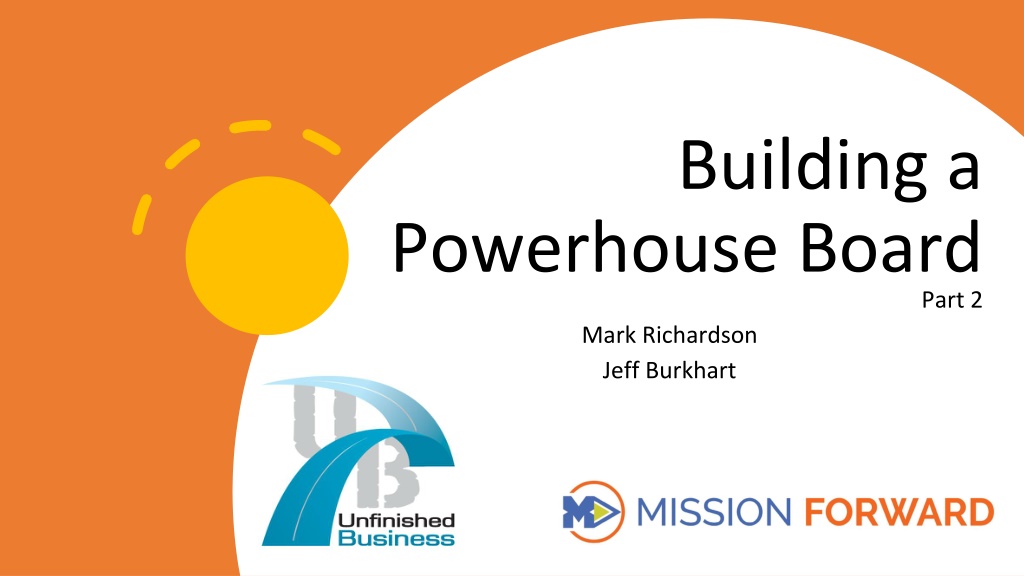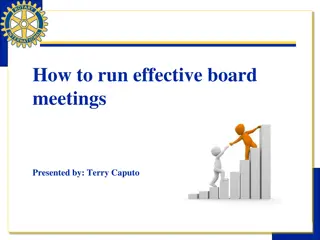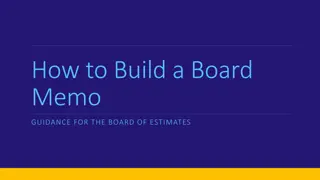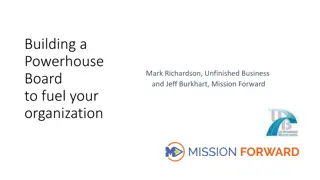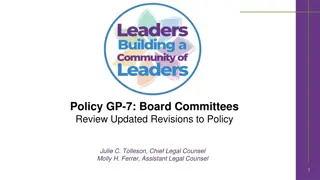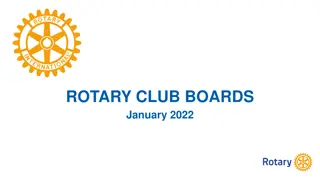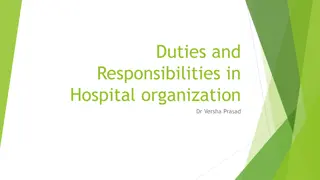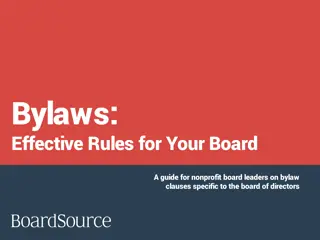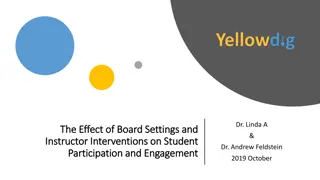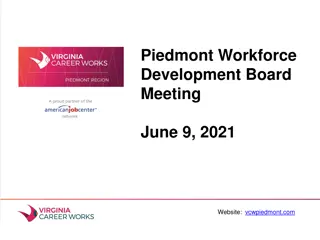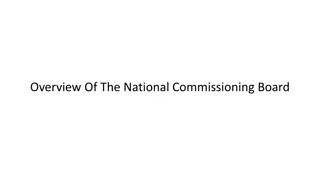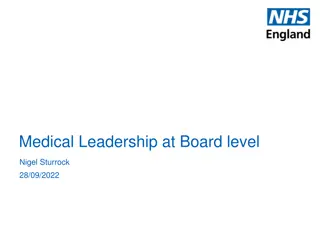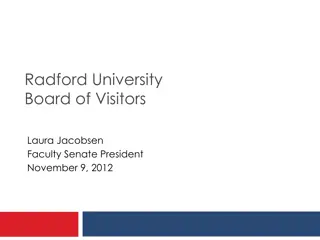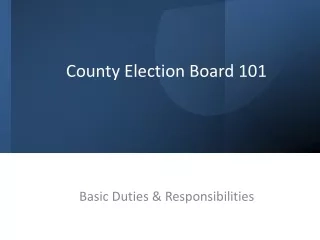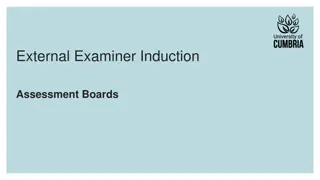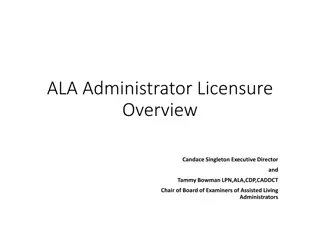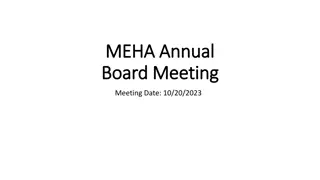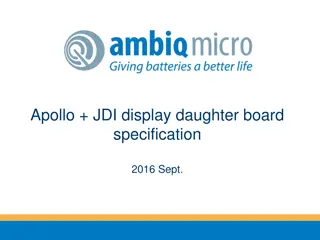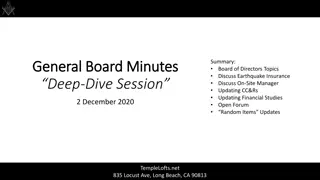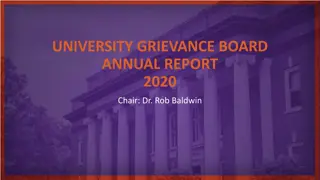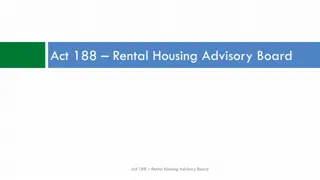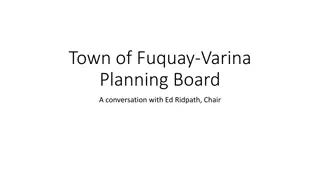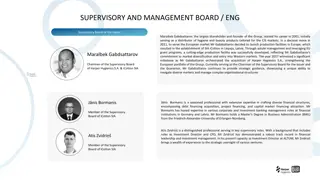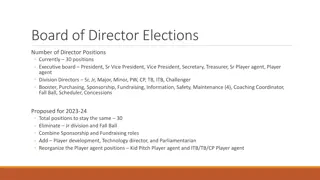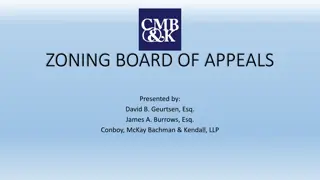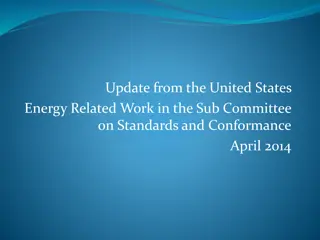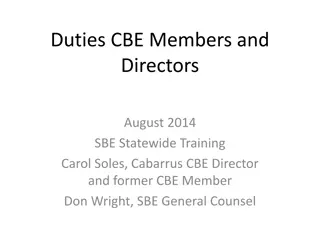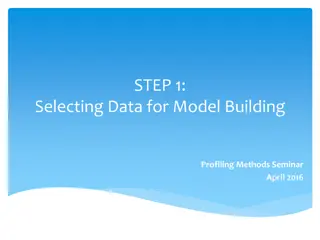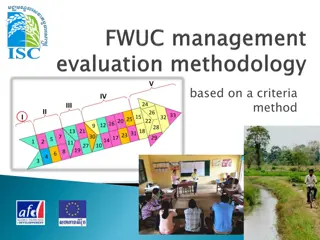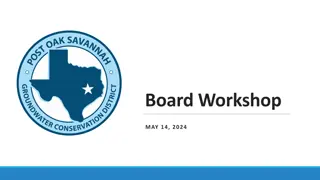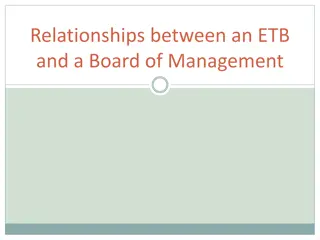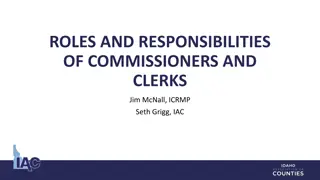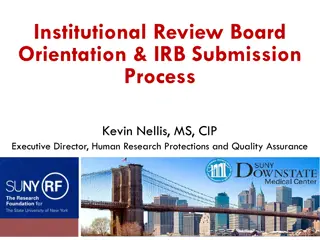Essential Steps for Building an Effective Board
Explore key strategies for enhancing board effectiveness, including defining roles, establishing clear responsibilities, setting goals, and ensuring regular communication and accountability. Emphasizing the importance of assessing current board dynamics, the document provides insights on creating a culture of collaboration and success within board governance.
Download Presentation

Please find below an Image/Link to download the presentation.
The content on the website is provided AS IS for your information and personal use only. It may not be sold, licensed, or shared on other websites without obtaining consent from the author. Download presentation by click this link. If you encounter any issues during the download, it is possible that the publisher has removed the file from their server.
E N D
Presentation Transcript
Building a Powerhouse Board Part 2 Mark Richardson Jeff Burkhart
Quick recap of session 1 Roles and Responsibilities Assessment Engagement Today s session Recruitment Onboarding Q&A Conclusion and Action Planning
1. Discuss board culture 2. Clear understanding of mission 3. Clarify priorities and critical issues, and individual interests in meeting them 4. Develop mutual agreement about board responsibilities and expectations 5. Create and sign a commitment form outlining these responsibilities 6. Develop board goals and committees based on these responsibilities 7. Create and stick to a regular schedule of check-in meetings on the goals 7 Step Process of Building a More Effective Board
This document should be reviewed, approved and a copy signed by all members of your current board. Create a clear responsibilities and duties document It highlights the key responsibilities and time commitments that each board member takes on when agreeing to serve your board. It should be used in board recruitment and orientation for future board years.
1.Attend at least 75% of board meetings, committee meetings, and special events. 1.Contribute at least two ideas for increasing visibility, speaking or networking opportunities, and/or suggest individuals who may be interested in volunteering or supporting the XYZ Org each month. Sample board commitments 1.Dedicate at least 4 hours a month to supporting XYZ Org activities. 1.Make a personal financial contribution at a level that is meaningful to you.
Regular board reports for each meeting Director reports: based on strategic initiatives approximately 2-3 page report that include successes, challenges and metrics Financial report: monthly and year-to-date revenues and expenditures compared to budget, explanation of any discrepancies, and a balance sheet Fund development report: list of proposals submitted, received and rejected. List of major gifts and any other relevant fundraising info Any background needed for decision making purposes at the meeting These should be provided a week before the meeting.
Assessing the current state of your board What strengths exist within your current board dynamics that should be celebrated and leveraged? What specific actions can be taken to make improvements?
Regular strategic communication is key to engagement. The executive committee of the board and the executive director collaboratively plan an agenda based on strategic goals. Enhancing board engagement The agenda is created at least a week in advance and provided to all board members. The agenda outlines decisions that need to be made. It serves as a reminder that the board meetings are important to the goals of the organization, and that connecting with fellow board members is vital to the health of the organization.
Identify specific strategic areas where the board can help. These may include annual fundraising campaigns, outreach/advocacy efforts, or organizational capacity- building initiatives. Assign specific manageable tasks, such as leading a fundraising committee, contacting donors to thank them for their support, representing the organization at community events, or providing expertise in a particular area. Set goals for quantifiable metrics. This could include number of donors reached, volunteer hours contributed, attendance at events, number of sponsors for an event, or other specific milestones within each initiative. Set realistic deadlines for achieving the goals related to each strategic initiative. This helps create a sense of urgency and accountability among board members. Engage your board in strategic initiatives
Regularly take time to discuss progress updates on board goals. Incorporate training and capacity-building activities into the board development plan. Diversify engagement opportunities to cater to different strengths and interests. Regularly celebrate achievements: awards, public acknowledgment, or special events Ask board members for feedback on the engagement process to identify areas for improvement, address challenges, and refine goals for future initiatives. Be adaptable and flexible in adjusting board engagement goals to align with the organization's changing needs and external circumstances. Engage your board in strategic initiatives
Authentic and Empathetic Communication: Report key organizational issues transparently and in a timely manner. Encourage active participation, feedback, and collaboration among board members. A sense of humor helps, too! Four keys to a Collaborative Relationship between the ED and board Mutual Respect: Collaborate on major decisions and strategic initiatives. Recognize and appreciate the unique roles and expertise each party brings to the organization. Continuous Learning: Incorporate ongoing education, skill- building, and development opportunities for board members. Regularly assess and refine roles based on the evolving needs of the organization. Cultural Competency: Provide regular training and support of cultural awareness, sensitivity, and competence as it relates to the services provided by the organization.
Healthy board and director relationships Board members participate diligently and actively in strategic initiatives, utilizing their strengths and networks to support goals. Board members feel knowledgeable about activities and actively engage in discussions. They ask questions if they don t understand. Board members feel trusted and respected, and the value and trust the executive director. They are partners in the work.
Healthy board and director relationships Staff openly share the good, bad and unpleasant news about the work Staff ask for help and advice in a positive, constructive and realistic way from board members. They understand board members are volunteers. Staff make communication with the board a regular priority.
Decision making and work plan Clearly documenting responsibilities ensures board accountability. Develop an annual calendar with: board meetings and committee meetings board development trainings financial audit discussions and budget meetings fundraising events and networking events annual board self-evaluations director evaluations any other regular events
Applying Insights: How can the insights gained from these case studies be applied to your organization's current challenges or opportunities? Potential Roadblocks: What potential roadblocks or challenges might your organization face when attempting similar board transformations? How could you overcome them? Case study review Sustainability and Longevity: How can the lessons learned from these case studies contribute to the long-term sustainability and success of your organization?
Get off to a good start: At your board orientation session, describe your plans for fundraising, and the importance of philanthropy in achieving the organization's objectives. Creating a culture of philanthropy Role modeling: Board members are more likely to engage in fundraising activities if they see board leaders actively participating. Be Clear: Communicate expectations for board members, both in terms of financial contributions and active involvement in fundraising efforts. Discuss these expectations during the recruitment process and annually during board evaluations.
A well-organized fundraising committee: - focus on bringing more supporters - share responsibilities for planning activities - provide guidance to other board members - schedule meetings far in advance Creating a culture of philanthropy Support stewardship: - ongoing support and training on donor stewardship - encourage board members to attend events, make personal donor calls, and participate in other forms of donor engagement.
Connect Board Members with your work: Facilitate respectful ways for board members to engage with programs and beneficiaries. Personal connections will increase their commitment and passion for the cause, helping them feel like their time and energy is making a difference, and making them more effective advocates for fundraising. Creating a culture of philanthropy Celebrate Successes: Acknowledge and celebrate fundraising successes regularly. Recognize and appreciate the efforts of individual board members to create a positive and motivating atmosphere.
Major Gifts: Boards can leverage their personal networks and relationships to secure significant donations from individuals, businesses, or foundations Annual Giving: Boards encourage regular giving from donors through personal thank you messages and phone calls to donors What engaged boards can do Peer-to-Peer Fundraising: Board members reach out to their networks, friends, and family to raise funds Special Events: Boards often organize and participate in special events such as galas, auctions, or charity runs, attracting community members and sponsors to contribute to the cause Corporate Partnerships: Boards can leverage their professional networks to establish and strengthen partnerships with local businesses for philanthropy and sponsorships
Engage a board nominating committee Assemble/review the board matrix Strategic board recruitment Determine the skills and number of board positions you need Create a board recruitment packet
A brief and friendly welcome letter An overview of your mission and impact Board responsibilities and expectations Board Recruitment Packet contents Job description for board members Current board roster Overview of your strategic initiatives Summary of your financial health Application process Contact information
Finding new board members Diversify Your Recruitment Approach: seek people from different backgrounds, experiences, and demographics to bring a variety of perspectives Use your networks: current board members can connect with people in their professional networks. Professional organizations, leadership development groups, and community partners can also help. Current Volunteers: Volunteers are often familiar with your organization and its mission. Identify high- performing volunteers who may be interested in taking on a leadership role on the board.
Finding new board members Maintain an Ongoing Pipeline: Cultivate an ongoing pipeline of potential board members. Regularly update and review your list of potential candidates, even when you are not actively recruiting. Assess Commitment and Passion: Assess not only skills and qualifications but also the candidate's commitment to your mission and passion for the cause. Individuals who are genuinely passionate about your organization are more likely to contribute meaningfully.
Onboarding new board members Prepare a welcome package with your mission, bylaws, current strategic plan, recent annual reports and newsletters Assign a current board member to serve as a mentor in the first few months Conduct a brief orientation session to help board members learn about your programs and services Have mentors schedule regular check-in meetings with new members to answer questions Assign to committees and share committee calendar/background information
At the first board meeting a warm introduction to new board members with introductions overview of the roles and responsibilities how the meetings typically run to help new members get up to speed
Facilitate tours between new board members and key staff members to provide insight Meet one-on-one with new board members Create a brief survey for new board members to evaluation their introduction experience so you can continuously improve the process Encourage new board to share their thoughts and perspectives Be grateful for their willingness to volunteer to advance your mission Publicly recognize their service on your website, newsletters and social media When a board member is recognized in the news, share it with the public and other board members. Encourage connection
Building a Powerhouse board is a planful process its an investment not an expense Openness and collaboration require shared power Board members are rooting for you and want to foster success Building the board takes time, patience, and commitment You can make the change you seek step by step Key takeaways
Take 10 minutes to write down 3-5 actions that you ll take in the coming week to build a better board. How will you know when you re successful? What will you do if you get off track? What three steps will you take?
Our contact info Mark Richardson www.unfinishedbusinessconsulting.com mark@unfinishedbusinessconsulting.com 608-658-5626 Jeff Burkhart www.missionfwd.org jeff@missionfwd.org 608-669-4447
